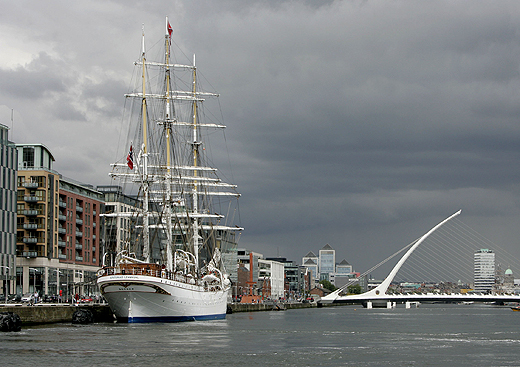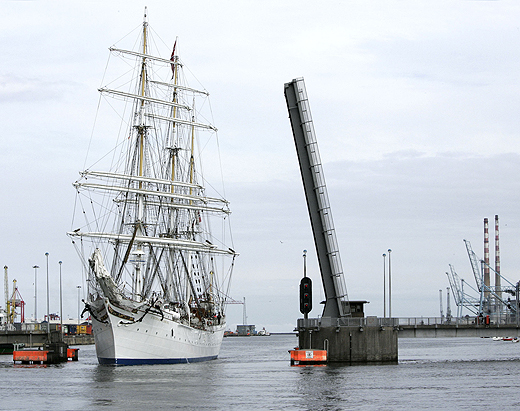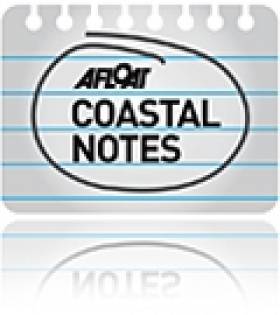Displaying items by tag: EastLink Toll Bridge
#EastLink@30 – Naval Service OPV L.E. Aisling (P23) took the honour of passing through Dublin's East-Link Toll Bridge as the Liffey road crossing celebrated opening to traffic 30 years ago today, writes Jehan Ashmore.
The final of the 'Emer' OPV class built sisters made the transit of the bridge built to a bascule design in which the 'lifting' span of 45 metres wide was raised. The opening span weighing 500 tons is tilted to 80 degrees and taking less than a minute to complete. This allowed the L.E Aisling to continue upriver to berth along Sir John Rogersons Quay.
When the bridge was opened on 21st October 1984, this created a new eastern by-pass of the capital however this was to be an end of era with the withdrawal of the Liffey ferry, albeit a foot-passenger only service.
The ferry was used as short cut mostly for 'dockers' as otherwise the next fixed link bridging the Liffey three decades ago was the Matt Talbot Memorial Bridge. This structure was close to where the last Guinness stout-ships berthed, The Lady Patricia and Miranda Guinness along Sir John Rogersons Quay.
The stout-tankers were the last ships to regularly transit the East-Link Bridge until 1993. They exported the 'black stuff' to Runcorn on the Manchester Ship Canal.
The East-Link Bridge has a strong commuter profile with approximately 17,500 vehicles daily using the bridge connecting the north and south quays. The bridge spanning 150 metres was the vision of Tom Roche (senior) founder of the National Toll Roads, the original operators of the tolled bridge.
Not only is the bridge used by car motorists but notably is a national strategic infrastructure asset for freight trucks to access the port. As the years passed with the opening of the Dublin Port Tunnel, this formed another key part of the overall port related road network and to further alleviate congestion away from the city-centre quays.
Another milestone in the infrastructure of bridging the Liffey was the Samuel Beckett Bridge which ironically itself made a transit through the East-Link Bridge. The structure was loaded on board a barge in The Netherlands and was towed to Dublin Port in 2009 for installation. The Samuel Beckett Bridge is of a swing-bridge design in which the whole bridge pivots on a single pier.
It was in May this year when another of the Naval Service's OPV's the newbuild L.E. Samuel Beckett (P61) moored close to the bridge also bearing the name of the playright as the vessel was christened along the south quays.
For a speeded up footage taken on board from the mast of the newbuild as she headed into Dublin Port and through the East-Link Bridge prior to her naming ceremony, click HERE.
Norwegian Tallship Opens to the Public in Dublin Docklands
The arrival of the largest and oldest Norwegian tallship the barque S/S Statsraad Lehmkuhl into Dublin Port yesterday made for an impressive sight, even without her sails set, writes Jehan Ashmore.



Her arrival marks nearly a year in advance to Dublin City welcoming the return of the Tall Ships Races, presented by Szczecin and organised by Sail Training International. The capital last hosted the event in 1998 and next year up to 100 tall ships are to sail into the capital which will be the final host port for four days between 23rd-26th August 2012.

Tall Ship S/S Statsraad Lehmkuh in Dublin Bay yesterday. Images: Iain White
The celebration of sail is expected to draw entrants from as far away as Chile, Mexico, Argentina, USA and European and Baltic countries including Italy and Norway will chart their course to Dublin. It is hoped that the event will attract over a million visitors to the city, topping the 500,000 spectators who thronged the Waterford quays during this year's tall ship race gathering.

Photo: Jehan Ashmore
Up Close and Personal: New Boat Tours of Dublin Port
In addition to cruising this stretch of the River Liffey alongside the 'Docklands' quarter, the tour RIB boat will pass downriver through the East-Link toll bridge where visitors will get closer views of the variety of vessels and calling cruise liners from other ports throughout the world.
There will be five daily tours beginning at 10.00am, 12.00pm, 2.00pm, 4.00pm and 6.00pm.Tickets cost €15.00 for adults, €12.50 for students and the charge for senior citizens and children is €10.00.
In addition Sea Safari operate a 'River Liffey' only tour, a Dublin Bay 'North' and 'South' tours which visit Howth Head, Baily Lighthouse, Ireland's Eye and to Dalkey Island and Killiney Bay, where both bay tours provide a chance to spot local marine wildlife of seals, porpoises and sea birds.
- Rib
- Dublin Port
- Dublin Docklands
- Howth Head
- marine wildlife
- Cruise Liners
- Sea Safari Tours
- Dalkey Island
- Port of Dublin
- River Liffey
- Ports and Shipping News
- EastLink
- EastLink Toll Bridge
- Dublin Port news
- Baily Lighthouse
- Killiney Bay
- Seabirds
- Port of Dublin news
- RIBcraft
- M.V. Cill Airne
- Dublin Port cruise liners
- North Quay Wall Dublin
- Dublin Bay tours
- Ireland's Eye
Largest Vessel Transits Samuel Beckett Swing-Bridge
She remained alongside this berth which is normally used by large commercial ships until the vessel sought a berth much closer to the city-centre. This led to a shift of berths in the evening when the 2003 built vessel headed upriver to the Dublin City Moorings facility at Custom House Quay, but this firstly required transiting through two bridges.
With a beam of 10.6m Fortunate Sun entered through the East-Link toll-lift bridge followed by the Samuel Beckett bridge, the Liffey's newest crossing point which opened in late 2009. The €60m bridge was commissioned by Dublin City Council and designed by the Spanish architect engineer Santiago Calatrava. To read more on the bridge click HERE.
Fortunate Sun is registered in the Caymen Islands and is capable of over 17 knots on a range of 5000 nautical miles. She has a steel hull and an aluminium superstructure and interiors also by Tim Heywood Design. In the early hours of tomorrow morning the vessel built by Oceanfast is to depart through the 5,700 tonnes bridge which was delivered by barge after a five-day voyage from Rotterdam.
There has been previous transits of the bridge notably the annual Dublin Rally organised by the the Inland Waterways Association of Ireland (IWAI). This year's Dublin Rally took place on 1 May when boats travelling on the Royal Canal descended via Croke Park and entered the Liffey at Spencer Dock. This required the Iarnrod Éireann bridge-lift and the water level in Spencer Dock to be lowered so to allow safe clearance under the Sheriff St. bridge.
From there the IWAI flotilla made the short passage downriver to re-enter another inland waterway system at the Grand Canal Dock, marking where the Liffey connects with the city's southern canal. The 2011 Dublin Rally was the first time since 1955 that boats could enter Dublin from the Shannon via the Royal Canal and the first time since 2004 that boats also joined from the Royal Canal.
- powerboats
- motorboats
- inland waterways
- Dublin Port
- Dublin
- Grand Canal
- IWAI
- Royal Canal
- DDDA
- Inland Waterways Association of Ireland
- Dublin City Council
- Spencer Dock
- River Liffey
- Ports and Shipping News
- EastLink Toll Bridge
- Dublin Port news
- Grand Canal Dock
- Dublin Docklands Development Authority
- M.Y. Fortunate Sun
- Tim Heywood Design
- Lifffey
- Dublin City Moorings
- Custom House Dock
- Powerboat news
- Motoryachts
- Sir John Rogerson Quay
- Inland Waterways news
- Dublin Rally
- Ianrod Eireann
- Oceanfast
- Scottish Western Isles
Lecture: “The Circumnavigation – Continued”
For further information on the lectures to date click this link and in general about the DBOGA logon here. To contact the PYBC Tel: (01) 668 9983 or logon to www.poolbegmarina.ie/
Lecture: "Diving The Wreck of the Bolivar on the Kish Bank"
The talks proper will begin at 8 pm but the organisers are encouraging those wishing to attend to assemble at 7.15 pm for a socialable drink in advance of the talk starting. All are welcome and the admission is free, noting a donation for the RNLI will be held at the door. For further information about the DBOGA logon to www.dublinbayoldgaffersassociation.com/
The Poolbeg yacht clubhouse is located on the South Bank, Pigeon House Road, Ringsend which can be accessed from the Sean Moore Road that connects the Merrion Strand Road (from the south) and the East-Link Toll Bridge (from the north). For information in general about the PYBC Tel: (01) 668 9983 or logon to www.poolbegmarina.ie/





























































